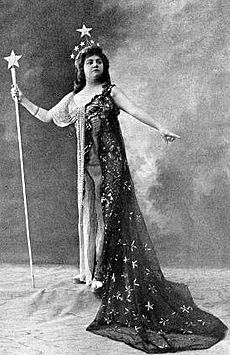Queen of the Night aria facts for kids
"Der Hölle Rache kocht in meinem Herzen" means "Hell's vengeance boils in my heart." This famous song, often called the Queen of the Night aria, is from Mozart's opera The Magic Flute (Die Zauberflöte). It's sung by the Queen of the Night, a character who sings very high and fast notes (a coloratura soprano).
In this part of the opera, the Queen is very angry. She gives her daughter, Pamina, a knife and tells her to kill Sarastro, who is her enemy. If Pamina doesn't do it, the Queen threatens to disown her and curse her. This song shows her fierce rage and desire for revenge. It's known for its high, quick notes and powerful sound, making it one of the most famous opera songs ever. The Queen also sings another well-known song earlier in the opera, "O zittre nicht, mein lieber Sohn".
What the Song Says (Libretto)
The words for The Magic Flute were written in German by Emanuel Schikaneder. He also led the acting group that first performed the opera and played the character Papageno.
Here are the words the Queen sings, first in German, then in English:
Der Hölle Rache kocht in meinem Herzen,
Tod und Verzweiflung flammet um mich her!
Fühlt nicht durch dich Sarastro Todesschmerzen,
So bist du meine Tochter nimmermehr:
Verstossen sei auf ewig,
Verlassen sei auf ewig,
Zertrümmert sei'n auf ewig
Alle Bande der Natur.
Wenn nicht durch dich Sarastro wird erblassen!
Hört, Rachegötter, hört der Mutter Schwur!
Hell's vengeance boils in my heart,
Death and despair blaze about me!
If Sarastro doesn't feel the pain of death through you,
Then you will not be my daughter anymore:
Disowned be you forever,
Abandoned be you forever,
Destroyed be forever
All the bonds of nature.
If not through you Sarastro will turn pale!
Hear, gods of revenge, hear the mother's oath!
The song is a powerful threat. The Queen says that if Pamina doesn't make Sarastro "feel the pain of death," then Pamina will no longer be her daughter. She threatens to cut all ties with Pamina forever if she fails. She even calls upon "gods of revenge" to hear her promise.
The Music Behind the Rage
{ \override Score.TimeSignature #'stencil = ##f \relative c { a4^\markup { "Tessitura" }\glissando c' s f,,^\markup { "Range" }\glissando f s } }
</score>{ #(set-global-staff-size 16) \relative c { \time 4/4 \key f \major \partial4 c8 c f4. f8 g4. g8 a2 r4 \acciaccatura { bes8( } a16)( g a bes) c8-. c-. c-. c-. c-. c-. c-. c-. } \addlyrics { mei -- ne Toch -- ter nim -- mer -- mehr, __ _ _ _ _ _ _ _ _ _ } } </score>
<score> { #(set-global-staff-size 17) \override Score.TimeSignature
- 'stencil = ##f
\relative c { \time 4/4 \key f \major f2 r4 \acciaccatura { g8( } f16)( e f g) a8-. a-. a-. a-. a-. a-. a-. a-. d,2 s8. } }
</score>This song is written in the key of D minor, which often sounds dramatic or serious. It uses a full orchestra, including flutes, oboes, bassoons, horns, trumpets, timpani (kettledrums), and the string section (violins, violas, cellos, basses). This is a bigger group of instruments than for the Queen's first song, making this one sound even more powerful.
The song is very challenging for singers. The Queen of the Night has to sing notes that cover two full octaves, from a low F to a very high F. This means she needs to have a very wide vocal range and be able to sing very high notes clearly and strongly.
One special moment in the music happens when the Queen sings "Hört, hört, hört!" (Hear, hear, hear!). She sings these words by herself, and then the orchestra plays loud chords. Mozart made the music here sound very surprising and intense. Instead of going to a note that listeners might expect, the music takes an unexpected turn, making the Queen's anger feel even stronger and more shocking. The violins also play together in a high, unified way to make the sound even more powerful.
Who First Sang It?
The very first person to sing this song on stage was Josepha Hofer, Mozart's sister-in-law. She was 32 years old at the time. People said she had an amazing voice that could reach very high notes and sing them quickly and clearly. Mozart knew how talented she was, so he wrote this song and her other famous aria to show off her incredible voice.
There's a story that Mozart himself was very impressed with Josepha's performance. It's said that on the last night of his life, about five weeks after the opera first opened, the dying Mozart whispered to his wife, Constanze, about Josepha's singing. He mentioned how strongly she sang a certain high note in "Der Hölle Rache," saying, "how strongly she strikes and holds the B-flat: 'Hört! hört! hört! der Mutter Schwur!'"
Many famous singers have performed this aria over the years. June Anderson sings it in the movie Amadeus. It was also a favorite song of Florence Foster Jenkins, an amateur singer known for her unusual performances.
A recording of this song, sung by Edda Moser with the Bavarian State Opera, was even sent into space! It's part of a collection of music from Earth on the Voyager 1 and Voyager 2 spacecraft, which are traveling far beyond our solar system.
See also
 In Spanish: Der Hölle Rache kocht in meinem Herzen para niños
In Spanish: Der Hölle Rache kocht in meinem Herzen para niños



